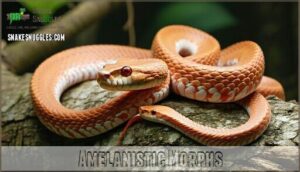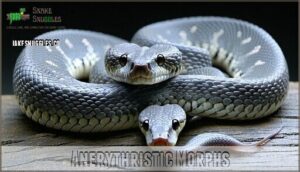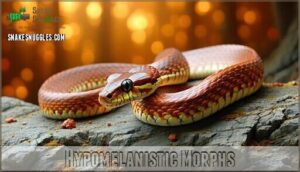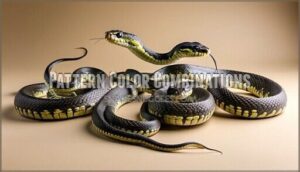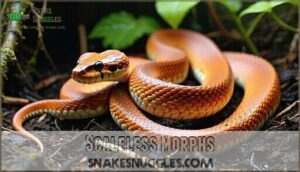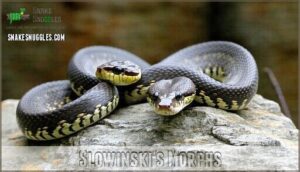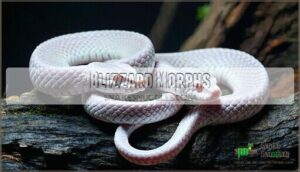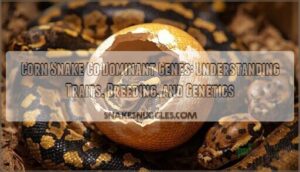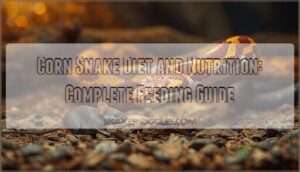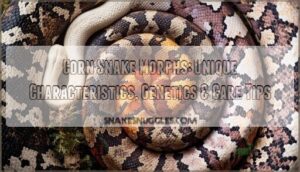This site is supported by our readers. We may earn a commission, at no cost to you, if you purchase through links.
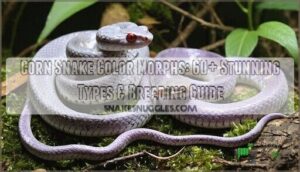
These morphs result from selective breeding that manipulates pigmentation genes.
Amelanistic morphs eliminate black pigment, producing vibrant "candy cane" snakes.
Anerythristic morphs remove red pigment, creating striking black-and-white patterns.
Popular morphs include snow (white with red eyes), lavender, and motley patterns.
Rare varieties like scaleless and Palmetto can cost thousands.
Understanding whether traits are recessive, dominant, or co-dominant helps predict breeding outcomes and explains why certain combinations produce such remarkable results in these collectible serpents.
Table Of Contents
- Key Takeaways
- Corn Snake Color Types
- Genetic Color Morphs
- Pattern Color Combinations
- Rare Color Morphs
- Breeding Color Morphs
- Frequently Asked Questions (FAQs)
- What are the different colors of corn snakes?
- What is the prettiest corn snake morph?
- Are pink corn snakes real?
- What is the color mutation in corn snakes?
- What colors do corn snakes come in?
- What is a ghost corn snake?
- What does a corn snake morph look like?
- How many corn snake morphs are there?
- Is a motley corn snake a color morph?
- What is a blue corn snake morph?
- Conclusion
Key Takeaways
- You’ll discover over 800 different corn snake morphs created through selective breeding that manipulates pigmentation genes, ranging from common amelanistic "candy cane" patterns to rare Palmetto morphs costing thousands of dollars.
- Understanding genetic inheritance patterns helps you predict breeding outcomes – most color traits follow recessive patterns requiring two copies of a gene, while some morphs, like blizzards, combine multiple genetic traits for stunning results.
- Three main genetic categories create the foundation for all morphs – amelanistic (removes black pigment), anerythristic (eliminates red/orange), and hypomelanistic (reduces black while keeping vibrant colors intact).
- Pattern variations, like motley, banded, and zipper, can combine with any color morph to create unique combinations, with rare specimens, like scaleless morphs, requiring specialized care due to their delicate, scale-reduced skin.
Corn Snake Color Types
You’ll discover four primary color categories that form the foundation of corn snake genetics.
Wild-type colors showcase nature’s earthy palette, while red, orange, and lavender morphs demonstrate selective breeding’s stunning results, including the impact of genetics.
Wild-Type Colors
Wildtype corn snake colors represent nature’s perfect camouflage solution, featuring earth tones that help these serpents disappear into their surroundings.
You’ll discover how regional variations create unique geographic colors across different populations, while natural hues showcase the foundation of all corn snake color morphs.
Here are four key wildtype characteristics you should know:
- Regional Variations – Carolina populations display different pigment production based on location
- Camouflage Patterns – Earth tones provide effective natural concealment in wild habitats
- Geographic Colors – Environmental factors influence wildtype coloration across snake populations
- Natural Hues – Wild genetics create the baseline for understanding all corn snake coloration
Red Morphs
Red morphs capture hearts with their stunning crimson patterns and vibrant red scales.
The blood red corn snake displays deep scarlet coloration that’s impossible to ignore.
Crimson corn snake varieties like Candy Cane feature white backgrounds with bold red patches.
Red coat corn snake genetics intensify natural reds, while red albino morphs combine amelanism with ruby tones.
Some red morphs even develop ruby eyes and fire belly characteristics that collectors absolutely treasure.
Understanding corn snake colors is essential to appreciating the unique traits of each morph.
Orange Morphs
Orange morphs showcase vibrant sunset hues that’ll make your collection pop.
These corn snake color morphs display warm tones from subtle peach colors to intense flame patterns. You’ll find stunning snake color variations in these specimens.
Here are four popular orange morphs to examine:
- Tangerine Snakes – Bright orange intensity with clean patterns
- Coral Morphs – Warm coral tones with reduced black pigmentation
- Apricot Patterns – Soft apricot hues through hypomelanistic genetics
- Nectar Hues – Golden-orange coloration with kastanie gene influence
Regional genetics substantially impact color expression in these specimens.
Lavender Morphs
You’ll discover that lavender morphs showcase stunning Purple Hues through complex Lavender Genetics.
These enchanting snakes develop deeper color variance as they mature, transforming from pale silver to rich purple-gray with ruby-red eyes.
The lavender gene creates mesmerizing lavender variations that make these morphs highly sought after.
lavender genetics from both parents
Proper lavender care guarantees superior Snake Behavior and health.
Strategic lavender breeding combines specific genetics to produce these remarkable specimens, with Morph Care requiring standard husbandry practices despite their premium pricing.
Genetic Color Morphs
You’ll discover the fascinating world of genetic color morphs when specific genes control pigment production in corn snakes.
These three main genetic categories—amelanistic, anerythristic, and hypomelanistic—create stunning color variations by removing or reducing different pigments in predictable inheritance patterns, which is a result of the interaction between these genes and the pigment production.
Amelanistic Morphs
Why wouldn’t you want to explore amelanistic genetics that eliminate melanin reduction completely?
These albino corn snakes display vibrant reds, oranges, and distinctive red eyes through recessive color inheritance.
Amelanistic morphs require both parents carrying the gene for proper morph expression.
This genetic variation creates stunning visual appeal while maintaining excellent health in captivity.
The study of albino corn snakes helps us understand the nuances of color morphs in these species.
Anerythristic Morphs
Anerythristic morphs showcase nature’s grayscale artistry through color reduction that eliminates red and orange pigments completely.
These anerythristic genetics create stunning monochromatic snakes displaying whites, grays, and blacks in striking patterns.
Snake morphology remains unchanged while genetic expression transforms their appearance dramatically.
Understanding anerythristic morph identification helps you recognize their distinctive cool-toned palette.
- Silvery scales shimmer like moonlight on water across their serpentine forms
- Bold charcoal saddles create dramatic contrast against pearl-white backgrounds
- Pattern alteration maintains classic corn snake designs in sophisticated monochrome
Snake color genetics make anerythristic traits highly valuable for breeding programs, producing countless designer combinations.
The care of these snakes requires understanding their specific habitat needs.
Hypomelanistic Morphs
Hypomelanistic corn snake morphs break free from standard genetics by reducing black pigment while keeping vibrant reds and oranges intact.
These reduced pigment beauties showcase bright scales that practically glow under proper lighting conditions.
Hypo Care requires standard husbandry with attention to color genetics stability.
Snake color patterns remain visible but softened through selective breeding programs.
Popular hypomelanistic morphs include:
- Ghost morphs – combining hypo with anerythristic traits creates ethereal, pale specimens
- Sunkissed variations – delivering golden undertones that shimmer like captured sunlight
- Ultra hypo lines – producing the brightest possible corn snake color morphs with minimal melanin
These morph patterns demonstrate how reducing one pigment type enhances others, creating hypomelanistic morphs that captivate collectors worldwide.
Pattern Color Combinations
Pattern combinations transform basic corn snake morphs into stunning visual masterpieces.
You’ll discover how motley, banded, zipper, and plain patterns interact with color genes to create unique phenotypes that showcase nature’s artistic potential, including how these patterns result in stunning visual effects.
Motley Pattern
Motley pattern breaks traditional corn snake rules with scattered, irregular blotches replacing neat saddle marks.
Motley genetics create this stunning disruption through simple recessive inheritance.
You’ll recognize motley identification by clean, unmarked bellies paired with broken dorsal patterns.
Motley variations range from subtle breaks to completely fragmented designs.
Snake morphology transforms dramatically as pattern variations scatter across the body.
Motley breeding requires two copies of the gene, producing reliable color combinations that collectors prize for their unpredictable beauty.
Banded Pattern
Banded snakes display horizontal stripes that create stunning visual effects across their entire body.
These Pattern Genetics produce complete rings wrapping from dorsal to ventral surfaces, distinguishing them from other Snake Morphs.
The banded pattern results from specific genetic combinations that affect melanin distribution during scale development.
Key characteristics of banded pattern corn snakes:
- Banded variations range from thin to thick horizontal stripes
- Banded aberrations create unique breaks or irregular spacing
- Banded breeding combines multiple color genes for enhanced contrast
- Banded intensity determines how bold the pattern appears
Banding Effects create remarkable symmetry that’s hard to miss.
These Stripe Morphs showcase Color Bands with consistent spacing and width.
Pattern Morphs like banded varieties offer breeders exciting opportunities to develop new Pattern Color Combinations through selective breeding programs.
Understanding corn snake genetics is essential for creating unique and stunning banded patterns in corn snakes.
Zipper Pattern
Two distinctive Zipper patterns break conventional saddle designs through interrupted borders and fragmented patches.
Zipper genetics create irregular, tooth-like formations along your snake’s spine that resemble actual zipper teeth.
| Pattern Feature | Description |
|---|---|
| Scale Texture | Smooth shifts between broken segments |
| Color Enhancers | Lighter hues highlight fragmented borders |
| Pattern Variations | Subtle breaks to dramatic zigzag designs |
| Morph Combinations | Compatible with most genetic lines |
Zipper identification becomes straightforward once you recognize the characteristic interrupted saddle borders.
Breeding zipper morphs requires patience since their rarity makes quality breeding stock challenging to locate in most collections.
Plain Pattern
Plain pattern corn snakes break free from traditional saddle designs, showcasing pure color beauty without complex markings. These uniform hues create stunning visual impact through simplicity.
Patternless morphs eliminate busy patterns that can mask underlying colors. You’ll notice how solid colors appear more vibrant when they’re not competing with intricate designs. Plain belly patterns complement the seamless appearance, while simple marks might appear as subtle variations rather than bold contrasts.
Scaleless morphs with minimal markings create an almost surreal appearance. Their scalereduced skin amplifies color saturation dramatically.
Here are five advantages of plain pattern genetics:
- Enhanced color clarity shows true pigment intensity
- Breeding predictability produces consistent offspring results
- Visual impact creates striking specimen displays
- Genetic compatibility pairs well with any color morph
- Collector value increases due to clean aesthetic appeal
These morphs prove that sometimes less truly equals more in corn snake genetics.
Rare Color Morphs
You’ll find some of corn snake morphs‘ most extraordinary specimens in the rare category.
These genetic treasures showcase mutations that create stunning visual effects like the all-white Palmetto with colorful speckles or the smooth-skinned Scaleless that amplifies every pattern and hue.
Scaleless Morphs
Since their discovery in 2002, scaleless morphs represent the ultimate achievement in corn snake genetics.
These extraordinary snakes lack most dorsal scales, revealing bare skin that amplifies color intensity dramatically.
The scale reduction creates stunning visual effects that’ll make your jaw drop.
Scaleless care demands specialized attention.
You’ll need smooth substrates like cypress mulch to prevent skin damage.
Higher humidity levels (65-75%) prevent dehydration since these snakes can’t retain moisture like scaled varieties.
Their delicate skin requires gentle handling and pristine enclosure conditions.
Microscale genetics produce fascinating variations within scaleless lineages.
Some retain partial scaling while others show complete dorsal scale absence.
This genetic complexity makes scaleless morph breeding both challenging and rewarding.
| Feature | Standard Corn | Scaleless Morph |
|---|---|---|
| Scale Coverage | Complete dorsal scales | Reduced/absent dorsal scales |
| Color Intensity | Normal pigmentation | Enhanced color saturation |
| Care Requirements | Standard humidity (50-60%) | Higher humidity (65-75%) |
| Market Price | $40-200 | $450-2,000+ |
These rare beauties command premium prices due to their extraordinary appearance and specialized breeding requirements.
Slowinski’s Morphs
Moving beyond scaleless morphs, you’ll discover Slowinski’s morphs offer another window into rare corn snake genetics.
Named after herpetologist Joseph Slowinski, these Slowinskis specimens showcase distinctive regional genetics from Louisiana, Arkansas, and Texas habitats.
Habitat Influence shapes their signature spearhead head marking and grayish-brown coloration with chocolate-brown blotches bordered in black.
Color Patterns differ from typical corn snakes, creating unique visual appeal.
Slowinskis Genetics currently features:
- Morph Variations – Two known types: silverleaf (recessive) and black varieties
- Snake Behavior – Medium-sized specimens with calm temperaments similar to standard corn snakes
- Breeding Programs – Limited availability due to wild-caught origins and recent discovery timeline
- Slowinskis Price – Typically around $100, reflecting their rarity in captive breeding programs
These Slowinskis morphs remain challenging to find compared to scaleless morphs, making them prized additions for collectors seeking something truly distinctive.
Palmetto Morphs
Among corn snake color morphs, palmetto morphs stand out as nature’s masterpiece. These rare color patterns feature white bodies with scattered red, orange, and yellow speckles – like nature threw confetti across pure canvas.
Nature’s artistry shines brightest in palmetto morphs – living confetti scattered across pristine white canvas.
Palmetto identification reveals each snake’s unique fingerprint since no two share identical patterns. Palmetto genetics follow incomplete dominance, making breeding tips essential for success.
- Snake habitat requirements match standard corn snake care – simple setup, moderate temperatures
- Palmetto care involves regular handling to maintain docility and monitor health closely
- Palmetto price reflects rarity, ranging $350-$775 based on pattern intensity and clarity
Morph genetics create unpredictable beauty every time.
Blizzard Morphs
While Palmetto morphs showcase dramatic white bodies with colorful speckles, Blizzard Genetics creates an entirely different spectacle through Snow Morphs. These blizzard morphs result from combining charcoal and amelanistic genes, producing what breeders call a White Out effect.
Blizzard appearance features pure white coloration with bright red eyes—imagine holding crystallized winter in your hands. Some specimens develop subtle Ice Patterns or Frost Bite markings that add character without compromising their snowy beauty.
Blizzard care follows standard corn snake protocols. They need proper heating, humidity, and feeding schedules just like any other morph.
Breeding blizzards requires both parents carrying the necessary recessive genes. It’s genetic lottery where patience pays off.
Breeding Color Morphs
Breeding corn snake color morphs requires understanding basic genetics and how recessive and dominant traits combine to create stunning variations.
You’ll need to track parent genetics carefully since most morphs follow simple inheritance patterns, with two copies of a recessive gene needed to produce the desired coloration in offspring.
Genetic Strains
Understanding corn snake genetics reveals the secret to creating stunning morphs through strategic breeding programs.
Your snake’s appearance depends on 33 genetic strains that combine through specific inheritance patterns called genetic mutations and gene expression.
These genetic strains determine color inheritance and morph genetics through selective breeding:
- Recessive genes require two copies from both parents to express visible traits
- Dominant alleles show up with just one copy from either parent
- Codominant traits blend characteristics when both genes are present
Trait selection becomes predictable once you understand how genetic mutations interact.
Five wild-type strains plus 28 selected genetic strains create the foundation for all corn snake morphs you see today.
By studying genetic code basics, breeders can better comprehend the complex interactions that shape their snakes’ appearances.
Breeding Techniques
Beyond genetic strains, successful Selective Breeding requires mastering proven breeding techniques. Morph compatibility drives your outcomes—pairing specific traits creates predictable results through careful Genetic Testing and strategic planning.
| Breeding Stage | Technique | Success Factor |
|---|---|---|
| Pre-breeding | Health screening & age verification | Mature specimens only |
| Pairing | Compatible morph selection | Genetic compatibility testing |
| Timing | Post-brumation cycles | Natural reproductive readiness |
| Incubation | Temperature & humidity control | Proper environmental conditions |
| Documentation | Lineage tracking systems | Accurate genetic records |
Breeding Programs benefit from understanding dominant versus recessive inheritance patterns. Hybridization Methods expand possibilities but require expertise.
Your Morph Creation success depends on documentation—track every pairing to predict future outcomes. Temperature manipulation during incubation can influence certain traits, giving you additional control over results.
Effective snake breeding also involves utilizing proper breeding kits to guarantee healthy offspring.
Color Variation Results
When you breed corn snake morphs, you’ll witness stunning color variation results that showcase the beauty of Color Genetics.
Your breeding projects reveal incredible Hue Variation through strategic Pigment Expression combinations.
Snake Camouflage patterns disappear as breeders create vibrant new looks.
Morph Patterns emerge from genetic lottery tickets – you never know what amazing combinations will appear in each clutch.
These corn snake color morphs demonstrate remarkable pigment production diversity:
- Amelanistic varieties: Bright reds and yellows minus black melanin
- Anerythristic specimens: Sharp grays with crisp pattern borders
- Lavender morphs: Purple tones that deepen over time
- Hypomelanistic types: Reduced dark pigments create softer appearances
- Multi-trait combinations: Complex genetics produce unexpected visual surprises
Understanding corn snake morphs requires studying snake breeding resources.
Your snake morphs will develop unique characteristics based on their genetic blueprint.
Some babies surprise you with colors that seem impossible – that’s the magic of breeding these incredible reptiles.
Pricing Factors
Several genetic and market forces determine corn snake prices.
Morph rarity creates the biggest price variation – rare Scaleless morphs cost $1,000+ while common types stay under $70.
Breeder fees reflect production complexity and lineage quality.
Market trends shift constantly based on demand influence from collectors seeking specific traits.
Understanding current snake price trends is essential for making informed purchasing decisions.
| Morph Type | Price Range |
|---|---|
| Common (Okeetee, Normal) | $30-$70 |
| Multi-gene combinations | $150-$300 |
| Rare (Palmetto, Scaleless) | $1,000-$4,000 |
| Proven breeding females | +30-50% premium |
Frequently Asked Questions (FAQs)
What are the different colors of corn snakes?
You’ll find corn snakes showcase incredible color diversity through selective breeding.
Wild types display earthy reds and browns, while morphs create stunning variations like snow-white, lavender, charcoal-black, and vibrant blood-red combinations.
What is the prettiest corn snake morph?
You’ll find beauty varies by personal taste, but Snow morphs captivate many with their pristine white bodies and subtle pink blotches.
Palmetto’s rare white canvas with colorful speckles also ranks highly among collectors.
Are pink corn snakes real?
Like rare gems hidden in nature’s treasure chest, pink corn snakes aren’t naturally occurring.
But you can find pinkish hues in certain morphs like Diamond babies and some Lavender variations that display beautiful pink undertones.
What is the color mutation in corn snakes?
Color mutations in corn snakes happen when genes alter pigment production.
You’ll see changes removing red (anerythristic), black (amelanistic), or both creating morphs like Snow.
These genetic variations produce over 800 different color combinations.
What colors do corn snakes come in?
You’ll discover corn snakes sport an incredible rainbow palette through selective breeding.
Wild types show earthy reds and browns, while morphs offer stunning whites, lavenders, charcoals, and vibrant oranges – over 800 mesmerizing color variations exist!
What is a ghost corn snake?
Ghosts haunt the corn snake world as hypomelanistic beauties.
You’ll recognize this morph by its dramatically reduced black pigmentation, creating ethereal pastels.
The ghost gene removes dark melanin, letting orange and red tones shine through translucent patterns that seem to float on pale backgrounds.
What does a corn snake morph look like?
Corn snake morphs display dramatically different colors and patterns from wild-type snakes.
You’ll see vibrant reds in Blood Reds, pristine whites in Snow morphs, deep purples in Lavenders, and striking patterns like Tessera’s stripes or Palmetto’s speckled appearance across various genetic combinations.
How many corn snake morphs are there?
Imagine a painter’s palette with endless possibilities – you’ll find over 800 different corn snake morphs available today.
Through selective breeding and genetic combinations, breeders have created this stunning diversity from wild-type foundations, which showcases the endless possibilities and stunning diversity of corn snake morphs.
Is a motley corn snake a color morph?
No, a motley corn snake isn’t a color morph—it’s a pattern morph.
You’ll see altered saddle patterns instead of different colors.
Motley genetics affect pattern formation, creating connected or broken designs while maintaining the snake’s natural coloration.
What is a blue corn snake morph?
Blue corn snakes aren’t a recognized morph. You might be thinking of "blue" phase wild corns or lavender morphs, which appear bluish-gray. Some folks confuse certain morphs with blue coloration.
Conclusion
Like a genetic kaleidoscope revealing nature’s artistic potential, corn snake color morphs showcase remarkable diversity through selective breeding programs.
You’ll discover that understanding recessive, dominant, and co-dominant inheritance patterns reveals successful breeding outcomes.
Whether you’re drawn to classic amelanistic varieties or rare Palmetto specimens, each morph represents years of careful genetic work.
These stunning corn snake color morphs transform basic orange-red patterns into extraordinary living artwork that continues fascinating reptile enthusiasts worldwide.
- https://resources.pangovet.com/pet-lifestyle/snakes/corn-snake-morphs-colors/
- https://iansvivarium.com/morphs/
- https://cornsnake.net/pages/corn-snake-morph-photos
- https://www.reddit.com/r/cornsnakes/comments/x1qff2/corn_snakes_breeding_phases_and_morphs/
- https://reptilesmagazine.com/color-patterns-of-corn-snakes-determined-by-single-gene/

